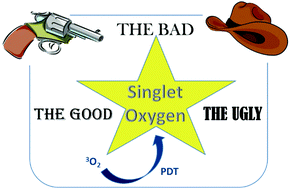当前位置:
X-MOL 学术
›
Photochem. Photobiol. Sci.
›
论文详情
Our official English website, www.x-mol.net, welcomes your
feedback! (Note: you will need to create a separate account there.)
The good, the bad, and the ugly – controlling singlet oxygen through design of photosensitizers and delivery systems for photodynamic therapy
Photochemical & Photobiological Sciences ( IF 2.7 ) Pub Date : 2018-03-20 00:00:00 , DOI: 10.1039/c8pp00008e Susan Callaghan 1, 2, 3, 4, 5 , Mathias O. Senge 1, 2, 3, 4, 5
Photochemical & Photobiological Sciences ( IF 2.7 ) Pub Date : 2018-03-20 00:00:00 , DOI: 10.1039/c8pp00008e Susan Callaghan 1, 2, 3, 4, 5 , Mathias O. Senge 1, 2, 3, 4, 5
Affiliation

|
Singlet oxygen, although integral to photodynamic therapy, is notoriously uncontrollable, suffers from poor selectivity and has fast decomposition rates in biological media. Across the scientific community, there is a conscious effort to refine singlet oxygen interactions and initiate selective and controlled release to produce a consistent and reproducible therapeutic effect in target tissue. This perspective aims to provide an insight into the contemporary design principles behind photosensitizers and drug delivery systems that depend on a singlet oxygen response or controlled release. The discussion will be accompanied by in vitro and in vivo examples, in an attempt to highlight advancements in the field and future prospects for the more widespread application of photodynamic therapy.
中文翻译:

好的,坏的和丑陋的-通过设计用于光动力疗法的光敏剂和输送系统来控制单线态氧
单线态氧虽然是光动力疗法不可或缺的,但众所周知是不可控制的,选择性差,在生物介质中分解速度快。在整个科学界,人们正在有意识地努力改善单线态氧的相互作用并启动选择性和受控释放,以在靶组织中产生一致且可再现的治疗效果。该观点旨在深入了解光敏剂和药物输送系统背后的当代设计原理,这些原理取决于单线态氧响应或控释。讨论将伴随着体外和体内 举例,以突出该领域的进展和光动力疗法更广泛应用的未来前景。
更新日期:2018-03-20
中文翻译:

好的,坏的和丑陋的-通过设计用于光动力疗法的光敏剂和输送系统来控制单线态氧
单线态氧虽然是光动力疗法不可或缺的,但众所周知是不可控制的,选择性差,在生物介质中分解速度快。在整个科学界,人们正在有意识地努力改善单线态氧的相互作用并启动选择性和受控释放,以在靶组织中产生一致且可再现的治疗效果。该观点旨在深入了解光敏剂和药物输送系统背后的当代设计原理,这些原理取决于单线态氧响应或控释。讨论将伴随着体外和体内 举例,以突出该领域的进展和光动力疗法更广泛应用的未来前景。











































 京公网安备 11010802027423号
京公网安备 11010802027423号